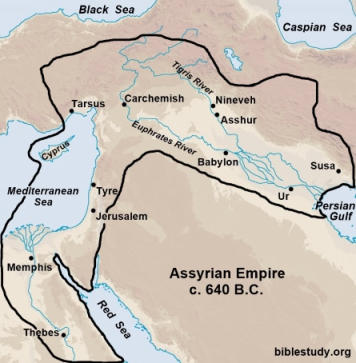Initially colonized by people from Babylon, Assyria rose to prominence on the world stage around 884 B.C. The empire, during Ashurbanipal's reign (c. 640 B.C.), controlled 540,543 square miles (1.4 million square kilometers) of land. Assyrian domination, which lasted for 272 years, ended when the Babylonians conquered and sacked their capital city of Nineveh in 612.
A number of Neo-Assyrian rulers mention contact with Hebrew kings. The Judean kings they mention include Azariah, Ahaz, Hezekiah and Manasseh. The kings of Israel (northern ten tribes) referenced include Omri, Ahab, Jehu, Menahem, Pekah and Hoshea. Below are the empire's interactions with both the Kingdom of Israel and the Kingdom of Judah based on both secular and Biblical history.
King Shalmaneser III (859 - 824 B.C.)
Shalmaneser III was the first Neo-Assyrian king to come in contact, and conflict, with God's people. Israel's King Ahab (874 - 853), along with a confederation of princes, fought against him at the battle of Qarqar in 853 (The Mysterious Numbers of the Hebrew Kings by Edwin R. Thiele). King Jehu of Israel (841 - 814) began to pay tribute money to him in 841 (ibid. pages 103 - 104).
It is believed that the earliest preserved depiction of an Israelite is that of King Jehu. The king appears on a black limestone obelisk (c. 825 B.C.) from Nimrud commemorating the deeds of Shalmaneser III. Jehu is shown, in front of Shalmaneser, kissing the ground. Inscriptions on the Obelisk state that the Israelite King cut his ties with the Kingdoms of Judah and Phoenicia and became subject to the Assyrians.

King Adad-nirari III (811 to 783)
Israel's King Jehoash, who ruled from 798 - 782 B.C., paid tribute money to King Adad-nirari III of Assyria possibly starting in 796.
King Tiglath-Pileser III (745 - 727 B.C.)
Tiglath-Pileser, in 2Kings 15:19 - 20 and 1Chronicles 5:26, is referred to as "Pul." Menahem, King of Israel (752 - 742), paid the Neo-Assyrians one thousand talents (75,000 U.S. pounds or 34,300 kilograms) of silver for them not to come up against him (Isaiah 7, 2Kings 15:19, 1Chronicles 5:26).
Assyrian records additionally state that Tiglath also had contact with King Azariah (Uzziah) of Judah and made him pay tribute as well.
King Ahaz of Judah (735 - 715) not only paid tribute to Tiglath-Pileser (2Kings 16:8), but also pleaded with the king to "Come up and save me from the hand of the king of Syria and from the hand of the king of Israel, who rise up against me" (verse 7). Tiglath-Pileser responded by attacking Damascus and executing its ruler in 732 B.C.
King Shalmaneser V (727 - 722 B.C.)
The Assyrian Shalmaneser initially came up against Israel and forced its king, Hoshea (732 to 723), to pay him taxes (2Kings 17:1 - 3). The king then "found treachery in Hoshea" and launched a three-year campaign against the capital city of Samaria beginning in 725.
And the king of Assyria found conspiracy in Hoshea: for he had sent messengers to So king of Egypt, and brought no present to the king of Assyria, as he had done year by year: therefore the king of Assyria shut him up, and bound him in prison (2Kings 17:4, KJV).
It was Shalmaneser, not his successor King Sargon II (in spite of Sargon's claims), who attacked and took Israel's capital. In 723 B.C. he conquered Samaria and took the Israelites living in the land as captives back to Assyria.
"Sargon claimed to have conquered the city (Samaria), but it is more likely that Shalmaneser captured the city since both the Babylonian Chronicles and the Hebrew Bible viewed the fall of Israel as the signature event of his reign" (Wikipedia article on Sargon II).
King Sargon II (722 - 705)
King Sargon II is believed to have assumed the throne after overthrowing Shalmaneser who may have been his brother.
King Sennacherib (705 - 681)
Sennacherib is the most Biblically famous of the Neo-Assyrian rulers. King Hezekiah of Judah, in 701 B.C., paid three hundred talents of silver and thirty talents of gold to the king, who was battling the nearby city of Lachish, not to further invade the kingdom (2Kings 18:13 - 16).
Sennacherib, in spite of receiving Hezekiah's treasure, dishonestly decides to send one of his generals with a huge army to Jerusalem. His purpose is to intimate Hezekiah and demand his unconditional surrender (2Kings 18:13 - 37). When the army arrives outside of Jerusalem, they boast that even the God of Israel was incapable of saving the city from their hand.
God, however, begs to differ with Assyria's arrogant pronouncements and sends the Angel of the Lord to kill 185,000 troops as they prepared to take Jerusalem (2Kings 18 - 19, Isaiah 37:33 - 38). Sennacherib and his forces end up experiencing the worst and most one-sided military defeat in Biblical (and human) history (2Kings 18 - 19, Isaiah 37:33 - 38)!
King Esarhaddon (681 - 669)
Neo-Assyrian king Esarhaddon is mentioned in Isaiah 37:38. Manasseh, king of Judah for 55 years (696 - 642), was the longest reigning monarch of both the kingdoms of Israel and Judah. Esarhaddon, and his successor, both claim that Manasseh paid tribute money to them (Mysterious Numbers of the Hebrew Kings).
King Ashurbanipal (668 - 627)
It is during the reign of Ashurbanipal that the Assyrian Empire reached its peak of power and territorial control. It was only after his death that Assyria began to decline to its ultimate demise.
Ezra 4:10 refers to this Assyrian king as Asnappar. Though not specifically named in the Bible, it is likely that Ashurbanipal was the person who captured Manasseh, placed him in shackles, and brought him as a prisoner to Babylon (2Chronicles 33:11). The king, after humbling himself and crying out to God, was allowed by the empire to return to Jerusalem (verses 12 - 13).